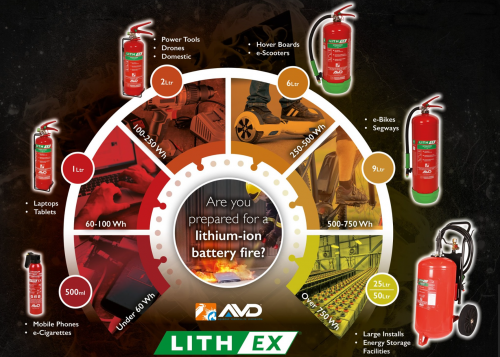Unfortunately, lithium-ion battery fires are taking up more space in the headlines. Do you have devices in your home or workplace that contain a lithium-ion battery? This includes mobile phones, laptops, UPS, and e-vehicles. What would happen if one of these items caught on fire?
“What many people don’t understand is that common extinguishers, like ABE Powder, CO2 or foam, will not extinguish a lithium-ion battery fire,” says Greg Ellis, Service Supervisor at Form1.
“If one of these fires starts in your home or building, hospital or aged care facility, you cannot put it out with water or a normal powder extinguisher.”
In the past, fire risks within a building were managed by various types of fire extinguishers that were available to market, including dry powder extinguishers, CO2, and foam. These extinguishers dealt with fires of varying classifications and met the needs of the most likely fire scenarios within buildings.
“Now, as new devices containing lithium-ion batteries become more prevalent it’s important to note that traditional forms of extinguishers, and water-based suppression, will not extinguish these types of fires,” says Greg.
While water can absorb heat from some small fires, it reacts dramatically with lithium. And once alight, lithium-ion battery fires are very hard to extinguish. They can burn fiercely, and in some circumstances, the battery can explode.
“Devices that use lithium-ion batteries include mobile phones and laptops – devices most of us have around us all the time,” adds Greg.
“Modern buildings are increasingly utilising lithium-based batteries. Being educated about their risks becomes more important as we transition our motor vehicles away from petroleum-based fuels to rechargeable electrics, which use large lithium-based battery packs.”

Revolutionary Technology to Combat Lithium-ion Battery Fires
While lithium-ion battery fires are currently a low probability, the consequences are very high. And as integration of technology into our lives has increased, so has the risk.
“As the world and modern technology advances the risk has changed significantly,” says Greg.
“A fire from a phone is one thing, but when you have 400kgs of batteries in an electric car burning, that’s significantly different and the fire brigade are still learning how to deal with fires of this type. Fire & Rescue NSW are working closely with leading scientific organisations to better understand how to rapidly and safely extinguish lithium-ion battery fires.”
Another issue with lithium-ion fires is they don’t burn cleanly. “These batteries can vent toxic gases and smoke into the surrounding area whilst alight,” says Greg.
The good news however is there are now fire extinguishers available to combat this unique type of fire. Aqueous Vermiculite Dispersion (AVD) fire extinguishing agent is a revolutionary technology that uses fixed and portable delivery techniques to combat lithium-ion battery fires – it is designed to put them out quickly, safely, and effectively.
“Until recently there hasn’t been a readily available extinguisher that deals with lithium-ion fires. Now, there are finally extinguishers that are commercially available and designed to target this type of fire. It’s a case of technology finally catching up to technology.”
The video below shows how an AVD Fire Extinguisher performs on a lithium-ion battery pack.
These extinguishers are now available. If you require further information, or would like us to assess your site risk and quote for their installation, please contact your local Form1 Fire branch.
Would you like a lithium-ion fire risk assessment for your building or facility? Click here to enquire about your Lithium-ion Fire Risk Assessment. Send us a message and we’ll be in touch to organise an assessment time that suits you. Please add the Subject: Lithium-ion Fire Risk Assessment and include the name of your facility and postcode.
Is your fire alarm system at risk in a storm? Click here to learn more.

